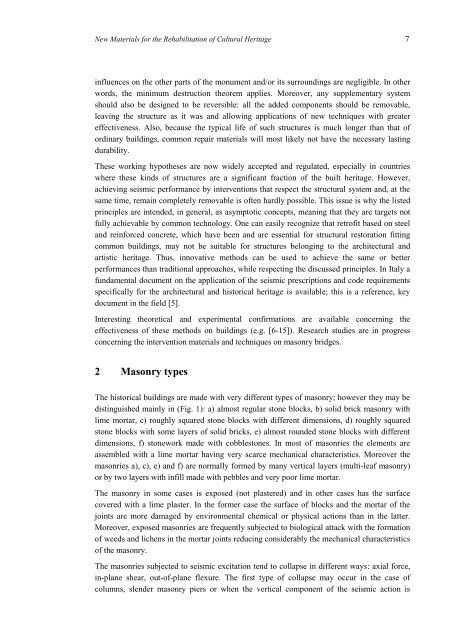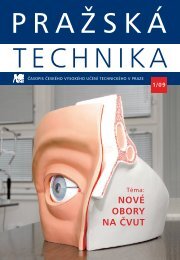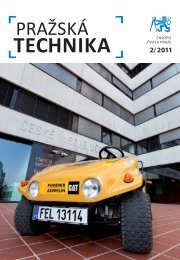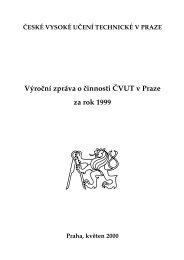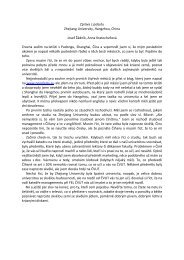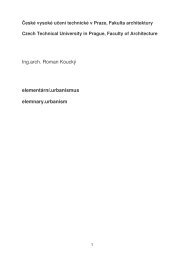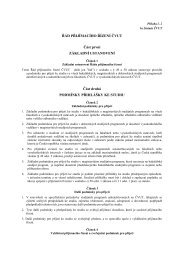New Materials for the Rehabilitation of Cultural Heritage - Czech ...
New Materials for the Rehabilitation of Cultural Heritage - Czech ...
New Materials for the Rehabilitation of Cultural Heritage - Czech ...
You also want an ePaper? Increase the reach of your titles
YUMPU automatically turns print PDFs into web optimized ePapers that Google loves.
<strong>New</strong> <strong>Materials</strong> <strong>for</strong> <strong>the</strong> <strong>Rehabilitation</strong> <strong>of</strong> <strong>Cultural</strong> <strong>Heritage</strong> 7<br />
influences on <strong>the</strong> o<strong>the</strong>r parts <strong>of</strong> <strong>the</strong> monument and/or its surroundings are negligible. In o<strong>the</strong>r<br />
words, <strong>the</strong> minimum destruction <strong>the</strong>orem applies. Moreover, any supplementary system<br />
should also be designed to be reversible: all <strong>the</strong> added components should be removable,<br />
leaving <strong>the</strong> structure as it was and allowing applications <strong>of</strong> new techniques with greater<br />
effectiveness. Also, because <strong>the</strong> typical life <strong>of</strong> such structures is much longer than that <strong>of</strong><br />
ordinary buildings, common repair materials will most likely not have <strong>the</strong> necessary lasting<br />
durability.<br />
These working hypo<strong>the</strong>ses are now widely accepted and regulated, especially in countries<br />
where <strong>the</strong>se kinds <strong>of</strong> structures are a significant fraction <strong>of</strong> <strong>the</strong> built heritage. However,<br />
achieving seismic per<strong>for</strong>mance by interventions that respect <strong>the</strong> structural system and, at <strong>the</strong><br />
same time, remain completely removable is <strong>of</strong>ten hardly possible. This issue is why <strong>the</strong> listed<br />
principles are intended, in general, as asymptotic concepts, meaning that <strong>the</strong>y are targets not<br />
fully achievable by common technology. One can easily recognize that retr<strong>of</strong>it based on steel<br />
and rein<strong>for</strong>ced concrete, which have been and are essential <strong>for</strong> structural restoration fitting<br />
common buildings, may not be suitable <strong>for</strong> structures belonging to <strong>the</strong> architectural and<br />
artistic heritage. Thus, innovative methods can be used to achieve <strong>the</strong> same or better<br />
per<strong>for</strong>mances than traditional approaches, while respecting <strong>the</strong> discussed principles. In Italy a<br />
fundamental document on <strong>the</strong> application <strong>of</strong> <strong>the</strong> seismic prescriptions and code requirements<br />
specifically <strong>for</strong> <strong>the</strong> architectural and historical heritage is available; this is a reference, key<br />
document in <strong>the</strong> field [5].<br />
Interesting <strong>the</strong>oretical and experimental confirmations are available concerning <strong>the</strong><br />
effectiveness <strong>of</strong> <strong>the</strong>se methods on buildings (e.g. [6-15]). Research studies are in progress<br />
concerning <strong>the</strong> intervention materials and techniques on masonry bridges.<br />
2 Masonry types<br />
The historical buildings are made with very different types <strong>of</strong> masonry; however <strong>the</strong>y may be<br />
distinguished mainly in (Fig. 1): a) almost regular stone blocks, b) solid brick masonry with<br />
lime mortar, c) roughly squared stone blocks with different dimensions, d) roughly squared<br />
stone blocks with some layers <strong>of</strong> solid bricks, e) almost rounded stone blocks with different<br />
dimensions, f) stonework made with cobblestones. In most <strong>of</strong> masonries <strong>the</strong> elements are<br />
assembled with a lime mortar having very scarce mechanical characteristics. Moreover <strong>the</strong><br />
masonries a), c), e) and f) are normally <strong>for</strong>med by many vertical layers (multi-leaf masonry)<br />
or by two layers with infill made with pebbles and very poor lime mortar.<br />
The masonry in some cases is exposed (not plastered) and in o<strong>the</strong>r cases has <strong>the</strong> surface<br />
covered with a lime plaster. In <strong>the</strong> <strong>for</strong>mer case <strong>the</strong> surface <strong>of</strong> blocks and <strong>the</strong> mortar <strong>of</strong> <strong>the</strong><br />
joints are more damaged by environmental chemical or physical actions than in <strong>the</strong> latter.<br />
Moreover, exposed masonries are frequently subjected to biological attack with <strong>the</strong> <strong>for</strong>mation<br />
<strong>of</strong> weeds and lichens in <strong>the</strong> mortar joints reducing considerably <strong>the</strong> mechanical characteristics<br />
<strong>of</strong> <strong>the</strong> masonry.<br />
The masonries subjected to seismic excitation tend to collapse in different ways: axial <strong>for</strong>ce,<br />
in-plane shear, out-<strong>of</strong>-plane flexure. The first type <strong>of</strong> collapse may occur in <strong>the</strong> case <strong>of</strong><br />
columns, slender masonry piers or when <strong>the</strong> vertical component <strong>of</strong> <strong>the</strong> seismic action is


